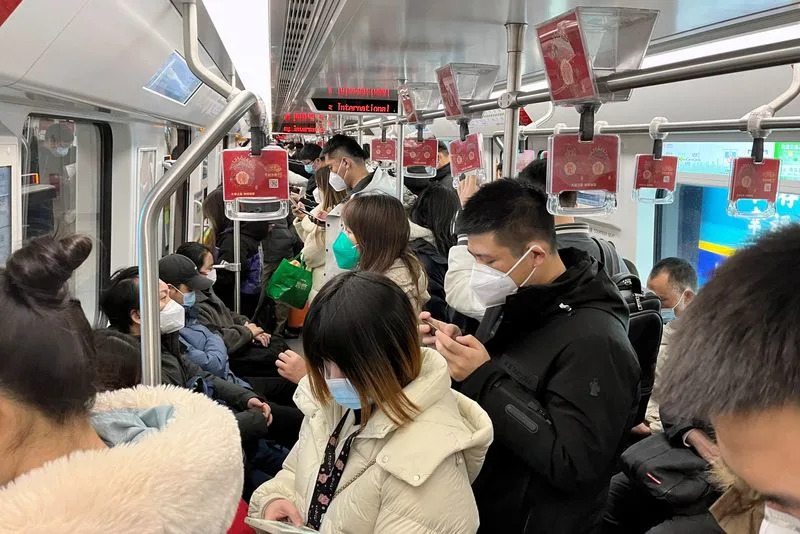Commuters from Beijing and Shanghai, wearing face masks, packed the subway trains on Monday. China’s two largest cities are getting closer to being able to live with COVID-19, as millions of people across the country have been infected with the largely uncontrolled virus.
After three years of relentless anti-coronavirus measures, President Xi Jinping this month abandoned the country’s “zero COVID” strategy of strict lockdowns and tests amid protests and a rising outbreak.
Health experts and residents fear that China’s statistics, which show no new COVID deaths in the six days leading up to Sunday, do not reflect the true death toll, and that China’s fragile health system country is being overwhelmed.
After the initial shock caused by the U-turn in the strategy, and after a few weeks in which people in Beijing and Shanghai stayed at home, either coping with the disease or trying to avoid it, there are signs that the Life is on the way back to normal.
Subway trains in Beijing and Shanghai were crowded, while some of the two cities’ main traffic arteries were clogged on Monday by slow commuting cars.
“I am prepared to live with the pandemic,” said Lin Zixin, 25, a Shanghai resident. “Lockdowns are not a long-term solution.
This year, in an effort to prevent infections from spiraling out of control across the country, China’s 25 million mall residents endured two months of bitter isolation under a strict lockdown that lasted until June 1.
The bustling streets of Shanghai were in stark contrast to the atmosphere of April and May, when hardly anyone was seen outside.
The annual Christmas market on the Bund, a commercial area of Shanghai, was very popular with the city’s residents over the weekend. Crowds turned out for the winter festivities at Shanghai Disneyland and Beijing’s Universal Studios on Sunday, lining up to ride the attractions in Christmas attire.
The number of trips to scenic spots in the southern city of Guangzhou this weekend increased 132% over the previous one, local newspaper The 21st Century Business Herald reported.
“Now basically everyone is back to normal routine,” said a 29-year-old Beijing resident surnamed Han. “The tense atmosphere has passed.”
China is the latest major country to move towards treating COVID as endemic. His containment measures had slowed the $17 trillion economy to its lowest growth rate in nearly half a century, disrupting supply chains and global trade.
According to analysts, the world’s second-largest economy is expected to continue to suffer in the near term, as the wave of COVID spreads to manufacturing areas and a sick workforce, before recovering next year.
Tesla suspended production at its Shanghai plant on Saturday, ahead of a plan to halt most work at the plant in the last week of December. The company did not give any reason.
RISING WAVE
The world’s most populous country has narrowed its definition to classify deaths as COVID-related, counting only those involving pneumonia or respiratory failure caused by COVID, which has raised eyebrows among global health experts.
The country’s healthcare system has come under enormous strain, with staff being asked to work while sick and retired medical workers from rural communities being rehired to help, according to state media.
The provincial government of Zhejiang, a large industrial province near Shanghai with a population of 65.4 million, said on Sunday that it was dealing with around a million new COVID-19 infections a day, a number that is expected to double in the next few days.
Health authorities in the southeastern province of Jiangxi have stated that infections will peak in early January, adding that further spikes could occur when people travel next month for Lunar New Year celebrations, state media reported.
They warned that the wave of infections would last three months and that around 80% of the province’s 45 million residents could become infected.
The city of Qingdao, in the eastern province of Shandong, estimated that up to 530,000 residents were infected each day.
Cities across China have rushed to add intensive care units and specialized fever clinics, facilities designed to prevent the further spread of contagious diseases in hospitals.
The Beijing municipal government has stated that the number of specialized fever clinics has risen in the city from 94 to nearly 1,300, according to state media. Shanghai has 2,600 such clinics and has transferred doctors from understaffed medical departments to help.
Concerns remain about the ability of China’s less prosperous cities to cope with a rise in serious infections, especially as hundreds of millions of migrant rural workers are expected to reunite with their families for the Lunar New Year.
“I am worried that the flow of people will be huge… (and) the epidemic will break out again,” said Lin, a Shanghai resident.

